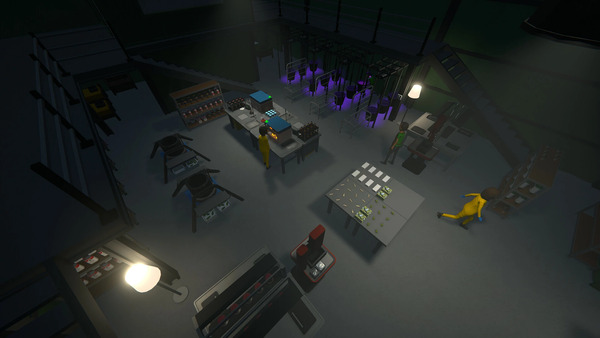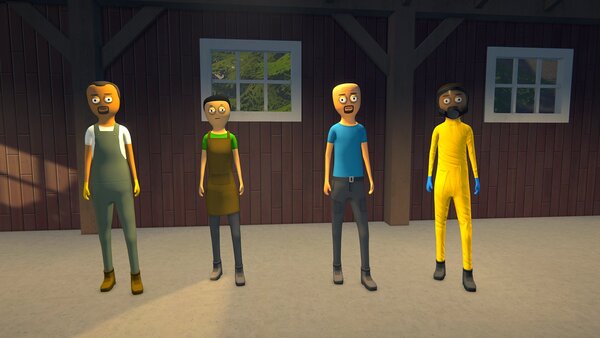Popular Now
In Schedule I, horror isn’t presented with cheap tricks or grotesque monsters. Instead, fear is crafted through space—specifically, the very architecture you move through. The game uses hallways, rooms, and floor plans as metaphors for control, suppression, memory, and identity. These aren’t just corridors connecting gameplay sections—they are a central storytelling mechanism.
This article takes a deep dive into the spatial design of Schedule I, focusing on how the game’s architecture acts as an extension of the oppressive system that controls the player. From sterile clinical wings to looping office corridors and abstract memory voids, the game’s environment manipulates psychology through spatial storytelling. We'll analyze 10 chronologically and thematically arranged segments of the game’s spatial evolution, showing how Schedule I turns walls and floors into instruments of surveillance and psychological pressure.

The Arrival Wing – Cold Open, Colder Geometry
Upon starting the game, players enter the Arrival Wing—a long, rectangular space lit with flickering LED panels and silent ambient noise. It’s devoid of decoration, furniture, or life. The architecture here is brutally efficient: no curves, no angles of comfort.
From the beginning, the game communicates that the building is not built for people—it’s built to manage them. Everything feels too symmetrical, too sterile. The spacing of doors is unnerving, neither evenly distributed nor truly random. It becomes clear that this environment is designed to unbalance the player’s spatial instincts.
The room isn’t just an introduction. It establishes Schedule I’s architectural language: oppressive, unyielding, and subtly hostile.
The Compliance Corridor – Linear Control
Once past the Arrival Wing, players reach the Compliance Corridor, a linear hallway with doors that open only under specific circumstances. The structure is algorithmic—doors only unlock after certain movements, interactions, or hesitations.
Here, the game begins tracking player choices through space. Turn left before being told to? That hallway leads to a dead end. Follow instructions to the letter? A side door opens that was previously locked.
The level design acts as a behavioral filter, rewarding obedience with accessibility. It’s not just spatial movement—it’s spatial conditioning.
Observation Hall – Transparent Isolation
The Observation Hall introduces windows—dozens of them. Each room you pass contains shadowy figures behind glass, some watching you, others seemingly unaware. The architecture flips from claustrophobic to performative.
This section explores architectural voyeurism. Every hallway is part of an invisible stage. The game uses lighting and one-way mirrors to simulate omnipresent surveillance. But the real twist is that you can see your past actions reflected—rooms replay earlier moments as projections or ghostly loops.
Spatial repetition and visual echoing make players question their autonomy. Are they being studied? Or are they studying themselves?
The Echo Loop – Spatial Recursion
One of the game’s most disorienting chapters occurs in the Echo Loop, a corridor that resets every time a door is opened. However, each reset is slightly altered: walls become narrower, objects appear and vanish, and the ceiling lowers incrementally.
The environment here weaponizes repetition. The player isn’t lost due to complex design—they’re trapped by recursive architecture. The tension escalates not from danger, but from the growing unease that comes from familiarity turned hostile.
This segment is a masterclass in psychological environmental design. It’s not a maze—it’s a cage with the illusion of exit.
The Maintenance Passage – Illusion of Freedom

Players eventually stumble upon the Maintenance Passage, an unmarked hallway not found on the building’s schematic map. Unlike the other areas, it’s dark, dirty, and looks like real people used it—scratch marks, graffiti, broken tiles.
At first, it feels like liberation. The space is less structured, less observed. But the longer you stay here, the more the environment deteriorates: the ceiling leaks, the walls close in, and the lights flicker erratically.
This passage is a false sanctuary. The architecture plays a narrative trick—presenting authenticity, only to decay into chaos the longer players resist the system’s main route.
The Office Cluster – Bureaucratic Dread
Mid-game introduces the Office Cluster—a looping structure of identical office spaces, cubicles, and administrative terminals. Players begin to realize that rooms are copied, sometimes mirrored, sometimes inverted.
There’s no logical floor plan. Trying to map the area results in impossible geometries. Desks are copy-pasted; file cabinets loop their drawers endlessly. Sometimes you exit a room and find yourself back inside it, but with subtle differences (papers missing, clocks rewound).
This space is a metaphor for bureaucratic self-cannibalism. The game uses space to reflect the absurdity of a system that consumes its own identity.
The Memory Archives – Non-Euclidean Trauma
The Memory Archives break the laws of physics. Here, gravity shifts, walls bend, and staircases rise in circles. You’ll walk through a door and emerge upside-down. Rooms connect to each other in ways that defy geometry.
In terms of gameplay, this segment is disorienting. But narratively, it represents the fragmentation of memory. These are not just corrupted areas—they’re unstable manifestations of suppressed personal experiences.
Schedule I turns architecture into mental architecture. You're no longer navigating a facility—you’re navigating fractured identities.
The Quiet Sector – Oppressive Stillness

Later in the game, the Quiet Sector offers a chilling inversion of earlier sections. There’s no surveillance here. No cameras, no lights, no windows. Just silence.
But the absence is haunting. The space is vast, open, and sterile. Footsteps echo too long. Doors creak in a way that feels amplified. The architecture simulates void—not just spatially, but emotionally.
This section reflects total erasure of the self. After all the observation, repetition, and fragmentation, this emptiness is the ultimate punishment: architectural isolation.
The Judgment Concourse – Spatial Tribunal
In the penultimate segment, players enter the Judgment Concourse—a cathedral-like space built entirely out of glass and mirrors. The architecture here is symmetrical, but with impossible depth. Walls stretch into infinity, reflecting the player from hundreds of angles.
This is the only space where the architecture literally watches back. Reflections move before the player does. Some copies speak or gesture. Others glitch or fade. Every direction is visible, every movement duplicated.
The building becomes the judge. No NPC delivers a verdict. The space does. Its perfection reveals the imperfections in the player’s journey—errors made, lies told, actions avoided.
The Exit Stairwell – Controlled Liberation

The final spatial experience is the Exit Stairwell, which is a vertical spiral climbing hundreds of floors. It’s a sterile white tower with soft, ambient humming and red emergency lights pulsing every 30 seconds.
At first, players ascend freely. Then stairways narrow. Steps become more difficult to climb. Breathing sounds begin to echo. Halfway through, descending is no longer possible. The stairwell has become a test of commitment.
At the top, there is no exit—only a window. Outside is a mirrored version of the entire building. The player realizes the climb was another layer of control. The architecture doesn’t lead to freedom. It leads to reflection.
Conclusion
The architecture in Schedule I is more than level design—it is a character, a system, and an oppressor. Through corridors that punish deviation, rooms that erase identity, and stairways that promise freedom only to deny it, the game tells a deeply personal story without dialogue or exposition. The walls speak, the layouts manipulate, and the spaces shape who you are inside the game.
This isn't just spatial horror. It's narrative engineering through bricks and beams. By the end of Schedule I, you realize you were never walking through a building. You were walking through yourself.


















